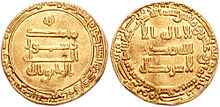Al-Wathiq
This article includes a list of references, related reading, or external links, but its sources remain unclear because it lacks inline citations. (April 2012) |
| al-Wathiq الواثق | |||||
|---|---|---|---|---|---|
 Gold dinar of al-Wathiq minted in Baghdad in 843 | |||||
| 9th Caliph of the Abbasid Caliphate | |||||
| Reign | 5 January 842 – 10 August 847 | ||||
| Predecessor | al-Mu'tasim | ||||
| Successor | al-Mutawakkil | ||||
| Born | 816 | ||||
| Died | 10 August 847 | ||||
| consort | Faridah | ||||
| |||||
| Dynasty | Abbasid | ||||
| Father | al-Mu'tasim | ||||
| Mother | Qaratis | ||||
| Religion | Islam | ||||
Abu Ja'far Harun ibn Muhammad al-Mu'tasim (Arabic: أبو جعفر هارون بن محمد المعتصم; 816 – 10 August 847), better known by his regnal name al-Wathiq bi'llah (واثق بالله, "He who trusts in God"), was an Abbasid caliph who reigned from 842 until 847 AD (227–232 AH in the Islamic calendar).
Biography
He succeeded his father, al-Mutasim, being hailed caliph on the day his father died, December 26, 841. Al-Wathiq was the son of the Byzantine Greek concubine Qaratis. She accompanied al-Wathiq's brother Jafar ibn al-Mu'tasim (the future caliph al-Mutawakkil) on the pilgrimage in A.H. 227. However, she died on the way on August 16, 842. She was buried in Kufa.
In A.H. 229 (843–844) al-Wathiq, remembering Harun al-Rashid's handling of the powerful Barmakids, arrested some of his prominent officials. These were tortured to encourage them to surrender funds they allegedly misappropriated.
In A.H. 230 (844–845) al-Wathiq sent one of his Turkish generals, Bugha al-Kabir (the Elder), to handle lawlessness in Arabia. A rampant tribe had defeated and killed the forces of Hammad ibn Jarir al-Tabari. Bugha al-Kabir promptly brought order there arresting a good number of miscreants. The next year, when Bugha was quelling disturbances elsewhere in Arabia, these prisoners attempted to escape. They were prevented and killed.
In A.H. 231 al-Wathiq secured an exchange of captives with the Byzantines. Al-Tabari records that 4,362 Muslims were reported freed in this exchange. This was the first time there was such a prisoner exchange since A.H. 194 (809–810) or 195 (810–811) in al-Amin's reign.
That same year there was a planned rebellion in Baghdad centred on Ahmad ibn Nasr ibn Malik. The uprising was scheduled for the night of April 4, 846. However, those who were supposed to sound the signal to rise did so a day early. There was no response. Authorities intervened. Ahmad ibn Nasr was arrested and brought before al-Wathiq. The caliph interrogated him, though more on approved religious belief than on scheming rebellion). Al-Wathiq, using a famous sword, personally joined in the execution.
The same year there was a break in at the palace treasury in Samarra. Thieves made off with 42,000 dirhams and a small amount of dinars. Security chief Yazid al-Huwani was tireless in his pursuit of them. They were caught.
In A.H. 232 (846–847) al-Wathiq sent Bugha al-Kabir to stop the depredations of the Banu Numayr. In al-Yamamah on February 4, 847 he fought a major engagement against them. At first he was hard pressed. Then some troops he had out raiding returned, fell upon the forces attacking Bugha and completely routed them.
Al-Wathiq showed an interest in learning similar to that of his father; thus he was a great patron of scholars, as well as artists. He was renowned for his own musical talents, and is reputed to have composed over one-hundred songs.
During his reign, a number of revolts broke out, the largest ones in Syria and Palestine. These revolts were the result of an increasingly large gap between Arab populations and the Turkish armies that had been formed by Wathiq's father, al-Mutasim. The revolts were put down, but antagonism between the two groups continued to widen, with the Turkish forces gaining power.
Al-Wathiq died on August 10, 847 of high fever. He was succeeded by his half-brother, al-Mutawakkil.
Assessment
Al-Tabari records that al-Wathiq was of medium height, handsome and well-built. He was fair with a ruddy complexion. His left eye was paralyzed.
A heavily fictionalized version of Al-Wathiq appears in William Thomas Beckford's classic 18th-century gothic fantasy novel Vathek.
Sources
- Kennedy, Hugh N. (2004). The Prophet and the Age of the Caliphates: The Islamic Near East from the 6th to the 11th Century (Second ed.). Harlow, UK: Pearson Education Ltd. ISBN 0-582-40525-4.
{{cite book}}: Invalid|ref=harv(help) - Kramer, Joel L., ed. (1989). The History of al-Ṭabarī, Volume XXXIV: Incipient Decline. The Caliphates of al-Wathiq, al-Mutawakkil, and al-Muntasir A.D. 841-863/A.H. 227-248. Albany, New York: State University of New York Press. ISBN 0-88706-875-8.
{{cite book}}: Invalid|ref=harv(help) - Turner, John P. (2013). "The Enigmatic Reign of al-Wāthiq (r. 227/842-232/847)". In Bernards, Monique (ed.). Abbasid Studies IV. Occasional Papers of the School of Abbasid Studies. Gibb Memorial Trust. ISBN 9780906094983.
{{cite book}}: Invalid|ref=harv(help)
